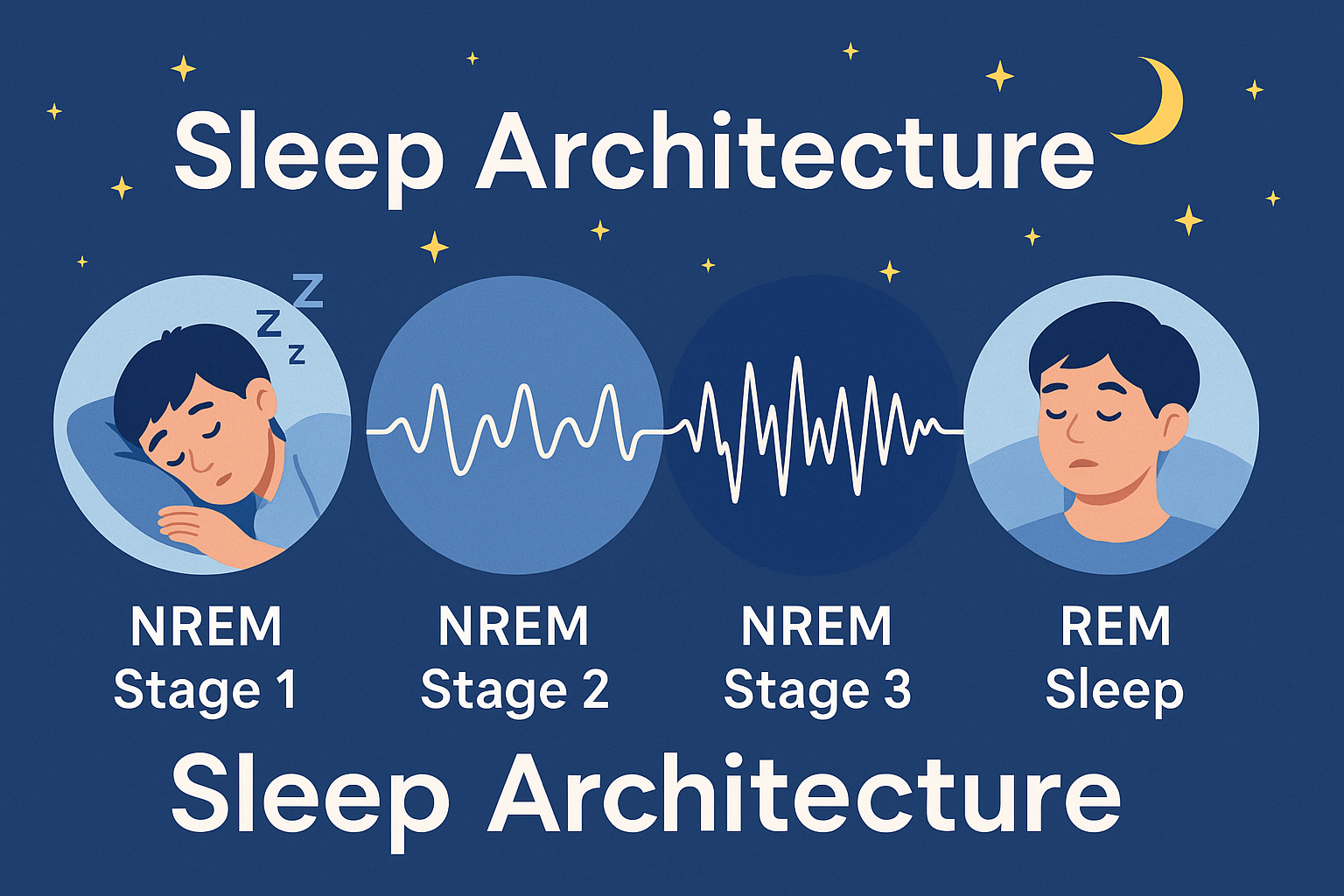
Sleep Architecture
🛏️ Introduction: Why Understanding Sleep Architecture Matters
Sleep is more than just rest—it’s a complex, structured biological process that determines how well your body and brain rejuvenate. This structure is known as sleep architecture, and it plays a vital role in cognitive performance, emotional regulation, hormonal balance, and overall health.
If you’ve ever wondered why 8 hours of poor-quality sleep can leave you groggy while 6 hours of good-quality sleep can feel refreshing, the answer lies in your sleep cycles.
🧠 What Is Sleep Architecture?
Sleep architecture refers to the pattern of sleep stages that your body cycles through during a night’s sleep. A full sleep cycle includes different phases, which repeat every 90–120 minutes, forming 4–6 complete cycles per night.
These stages are categorized into:
- NREM (Non-Rapid Eye Movement) sleep
- REM (Rapid Eye Movement) sleep
Each phase has unique roles in brain and body repair.
🌀 The Four Key Stages of Sleep Explained
- Stage 1 (N1) – Light Sleep
- Lasts 1–7 minutes
- Transitional phase between wakefulness and sleep
- Muscle activity slows, and you may experience hypnic jerks
🔍 Importance: If disrupted here, you may not feel like you’ve slept at all.
- Stage 2 (N2) – Onset of Sleep
- Lasts 10–25 minutes per cycle
- Heart rate and temperature drop
- Brain produces sleep spindles and K-complexes
🔍 Importance: Enhances memory consolidation and motor skills.
- Stage 3 (N3) – Deep Sleep (Slow-Wave Sleep)
- Lasts 20–40 minutes (earlier in the night)
- Brain waves slow down drastically
- Hardest to wake up from
🔍 Importance: This is the most restorative stage, essential for tissue growth, immune function, and detoxification via the glymphatic system.
- REM Sleep – Dream Phase
- Occurs ~90 minutes after falling asleep
- Brain activity increases; dreams occur
- Body is paralyzed (REM atonia) to prevent acting out dreams
🔍 Importance: Supports emotional health, creativity, and learning.
🔄 Sleep Cycles Throughout the Night
- Each night, your body goes through 4–6 complete sleep cycles
- Earlier cycles contain more deep sleep
- Later cycles have longer REM phases
Maintaining balanced sleep architecture ensures all stages are completed for optimal health.
🔦 Factors That Disrupt Sleep Architecture
❌ Sleep Disruption Triggers:
- Blue light exposure before bed
- Stress and anxiety
- Irregular sleep schedules
- Caffeine or alcohol late in the day
- Sleep disorders (e.g., insomnia, sleep apnea)
Disruptions in any stage—especially REM and deep sleep—can affect memory, energy, and overall well-being.
🌙 How to Improve Sleep Architecture Naturally
✅ Healthy Habits:
- Follow a consistent sleep-wake routine
- Reduce screen time before bed
- Avoid stimulants (caffeine, nicotine) after 3 PM
- Create a sleep-conducive environment: cool, dark, and quiet
- Exercise regularly but not too close to bedtime
🧪 Tools to Analyse Your Sleep Architecture
- Sleep trackers (wearables like Fitbit or Oura Ring)
- Polysomnography (clinical sleep studies)
- Sleep apps that monitor sounds and movement
These tools help you identify imbalances and take steps to improve sleep stage distribution.
🧘 The Role of Lifestyle and Nutrition
- Magnesium, melatonin, and glycine support better sleep
- Mindfulness, yoga, and deep breathing improve REM sleep
- Avoid heavy meals right before bed
📚 Conclusion: Mastering Sleep Architecture for Healthier Sleep
Understanding and optimizing your sleep architecture is the foundation of restorative sleep. Each stage—light, deep, and REM—has a critical role in rejuvenating your mind and body. Prioritize healthy habits, regulate your circadian rhythm, and eliminate sleep disruptors to unlock the full benefits of your nightly rest.
❓ 10 FAQs Not Covered in Article
- Can poor sleep architecture lead to mental health issues?
Yes, disrupted REM sleep is linked to depression and anxiety. - How long is a full sleep cycle?
Typically 90 to 120 minutes. - Does age affect sleep architecture?
Yes, deep sleep decreases and lighter sleep increases with age. - Is dreaming essential for health?
Yes, dreams (in REM sleep) help with emotional regulation and memory. - Does sleeping in chunks (polyphasic sleep) affect architecture?
It can fragment cycles, reducing deep and REM sleep quality. - What’s the ideal amount of REM sleep per night?
Around 20–25% of your total sleep time. - Can naps disturb your nighttime sleep structure?
Long or late naps may delay deep sleep at night. - How do medications affect sleep architecture?
Antidepressants and sedatives often reduce REM sleep. - Does alcohol improve deep sleep?
No, it may induce sleep quickly but reduces REM and disrupts cycles. - Is poor sleep cycle a sign of insomnia?
Yes, frequent awakenings and short sleep duration disrupt architecture.
